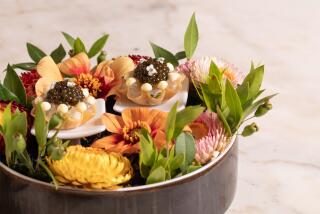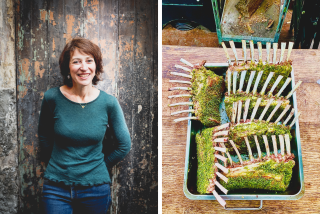Gilding the Fruit
- Share via
My first experience with Grand Marnier came early. Though I was only 5, I still remember the exotic flavors of the crepes sold on the main square park in Juan-les-Pins in the South of France. The man behind the storefront counter made the crepes to order, splashing them with Grand Marnier and sprinkling with granulated sugar. There wasn’t nearly enough of the amber liquor to get anyone drunk, but the aromas, especially to a child, were utterly intoxicating.
Most of my encounters with Grand Marnier in the years that followed occurred at dinner parties, when, in a moment of inspiration, the host poured the viscous liquor--which is a blend of Cognac and the essence of wild tropical oranges--over vanilla ice cream. In Southern California, Grand Marnier also frequently appears in top-shelf margaritas, with bartenders using it as a costly substitute for less expensive Triple Sec.
Until recently, I preferred Grand Marnier on its own as an aperitif. This was particularly true after I was offered a taste of Cent Cinquantenaire, a pricey bottle of Grand Marnier that was first produced in 1977 to commemorate the 150th anniversary of the company. The Cent Cinquantenaire blend uses only Cognacs up to 50 years old and grown primarily in the Grande Champagne region. The result is a lighter, spicier and more complex blend, with a subtle hint of chocolate not found in the regular bottle. This is worth drinking on its own, and is way too good--and, frankly, expensive at upward of $150 per bottle--to end up in any kind of dish or margarita, though some bars do pour it in their best cocktails.
Many local restaurants are cooking with Grand Marnier to great effect, and not just in desserts. Sure, it shows up in souffles all over town, from Le Dome to Whist and Hotel Bel-Air. Dolce uses it in its orange zest crepes, and it flavors ice cream at Jer-ne at the Ritz-Carlton in Marina del Rey. And gilding the lily at Hotel Le Bristol in Paris, the Cent Cinquantenaire decadently appears in a pancake flambeed with the commemorative Grand Marnier, served with stewed autumn fruits and chilled satsuma and fig pulps.
Chef Robert Gadsby uses Grand Marnier in the preparation of a main course--yellowfin tuna and caviar with mixed bitter greens and soy olive oil--at Noe, his new restaurant in the Omni Los Angeles Hotel at California Plaza. He poaches a kumquat in Grand Marnier and various juices and spices, and serves it in a sake cup along with the fish. The combination of the tart fruit and the orange-infused liquor works well, Gadsby promises, with high-fat meats such as duck, and is equally delicious and effective in adding a shot of flavor to everything from chicken and rabbit to pork and venison.
Just thinking about those kumquats poached with Grand Marnier gives me an idea--serving an entire meal where each course from salad through dessert features some of the sweet, syrupy liquid. And what to drink? Cent Cinquantenaire, of course.
*
Poached Kumquats
Serves 6 as a side dish
(Adapted from a recipe by chef Robert Gadsby, Noe Restaurant, Los Angeles)
1 1/4 cups freshly squeezed orange juice
6 tablespoons simple syrup
1 tablespoon fresh lime juice
2 tablespoons Grand Marnier
1 large sage leaf
12 kumquats
6 ounces soju
Place all ingredients in a small saucepan. Bring to a simmer over medium-high heat. Reduce heat and simmer gently for 8 minutes, or until kumquats are soft. Remove saucepan from heat and set aside to allow mixture to steep until the juice cools to room temperature. Remove sage leaf and transfer mixture to a jar. Cover and refrigerate until mixture is chilled. To serve, place two kumquats in a sake cup and cover with 1 ounce of soju. Repeat for all six servings. Save poaching liquid for another use.
*
Chris Rubin is a frequent contributor to the magazine.


